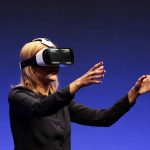
Virtual reality could help people get over their fear of public speaking
Monday, September 03, 2018 by Edsel Cook
http://www.realsciencenews.com/2018-09-03-virtual-reality-could-help-people-get-over-fear-of-public-speaking.html

The fear of public speaking can prevent otherwise brilliant people from sharing potentially valuable ideas with the world. In a News Wise article, Texan researchers propose that this debilitating fear can be overcome through the use of virtual reality technology.
Public speaking is considered to be one of the greatest and most common fears for the longest time. Many people are terrified by the mere idea of talking to a crowd. An actual session is a nerve-wracking ordeal for them.
As a stressor, public speaking can trigger the sympathetic autonomic nervous system. The result is a fight-or-flight response that normally only comes up in dangerous situations.
Such a phobia is a huge handicap in a world where individuals need to talk to each order so that they can exchange useful ideas. And yet it afflicts many people who are normally good at talking with their peers in a casual environment, causing them to freeze up in a professional or technical setting. (Related: Virtual reality now being used for pain intervention and PTSD treatment.)
Virtual reality can replicate public environments for training public speaking skills
Texas A&M University (Texas A&M) researchers Dr. Theodora Chaspari and Dr. Amir Behzadan are looking for ways to improve the public speaking skills of science, technology, engineering, and mathematics (STEM) students. Their approach involves the use of virtual reality technology to assist students in overcoming their fear.
“In particular, the goal of this project is to create more opportunities for students to present in a public setting for varying audiences that go beyond their comfort zone while teaching them how to be effective and concise in their speech and to manage their anxiety,” Chaspari explained.
His team is integrating wearable electronics and virtual reality devices to create interventions for public speaking. These approaches are also intended to be affordable and customized according to the needs of the individual user.
Chaspari and Behzadan believe that the combination of information and communication technologies, educational methods, and customized learning experiences will help educators to make a better learning environment for their students. These tools will be able to improve the communication and interpersonal skills of a student.
Their project employed a virtual reality interface to replicate a public speaking environment. They can manipulate attentiveness, engagement, perceptions, and other attributes of the virtual audience. They are also adding trials that host different kinds of audiences, presentations, or social settings.
Users can access the virtual reality app on their smartphones. Once they don a VR headset, they can interact with the simulation.
VR-based public speaking training for college students and millenials
The Texas A&M team acknowledged that most studies on the use of virtual reality to improve public speaking skills were restricted to laboratories. Earlier studies also failed to follow up on the results of using wearable technology. The jury is therefore still out on whether or not real-time feedback is able to improve the public speaking skills of a user.
Chaspari said that the team has taken that as a challenge. Their work uses smartphone devices and wearable technology that are owned and used by many college students and millennials. Their approach is very widespread, cost-effective, and easy to replicate and scale up.
“We deploy low-cost consumer-grade smartwatches, smartphones and VR headsets to investigate in-the-moment public speaking interventions within a virtual learning environment and their potential benefits compared to interventions administered in a traditional learning environment,” he remarked.
The technology is able to keep track of its user’s physiology and speech patterns. It can interpret those bio-signals to appraise the effect of public speaking areas. Finally, it provides real-time feedback on the user’s progress.
Curious about VR systems? Then go to VirtualReality.news for more articles.
Sources include:





